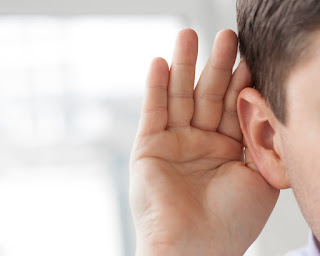Eight Actions to be an Exceptional Listener
By Stacey Hanke
Most people consider themselves to be good listeners, finding it hard to admit otherwise. We know listening is vital to building strong relationships with coworkers, managers, clients, and leadership. In fact, it is considered to be the single most important communication skill necessary, valued more highly than speaking, in the business world.
Most people consider themselves to be good listeners, finding it hard to admit otherwise. We know listening is vital to building strong relationships with coworkers, managers, clients, and leadership. In fact, it is considered to be the single most important communication skill necessary, valued more highly than speaking, in the business world.
We spend between 70 to 80% of each day engaged in communication, with over half that time devoted to listening, and yet we struggle to do it effectively. Because we hear speech at a rate of 500-1000 words per minute, and only speak 125-175 words per minute, we become easily bored, distracted and inattentive.
By recognizing listening as a skill necessary to establish and grow business relationships, we can begin prioritizing our need to do it well. Here are eight ways to immediately stop talking and start listening:
1. “My Turn, My Turn!”
Admit it, when others start speaking you immediately begin thinking of what to say next. Speaking may be considered relatively easy by most, many fail to effectively listen. Stop competing for your turn to talk and simply listen. Deliberately concentrate your focus on the speaker, keeping natural eye contact, and tune into their facial expressions and body language. Clear your mind and focus on the message until they have completed their thoughts.
2. “Wait, let me get that.”
Few things are as inconsiderate or hard to ignore like the distraction of a device; yet, many of us are guilty to giving in to its demand for our attention. Even when we try, it is next to impossible to concentrate on someone speaking when the phone sitting next to us is buzzing with text messages, alerts, emails, and phone calls. If you’re in a conversation, silence your device. Give your respect to those speaking by removing any distractions that may compete with their message.
3. “I see. Go on.”
Active listening is more than just hearing what someone says, it’s about the desire to understand what someone is trying to convey. Mindtools - a career skills development group - reported that people only remember between 25-50% of what is heard, meaning we pay attention to less than half of what someone says. By using words of encouragement such as “I see” and “Go on,” we can boost our ability to retain conversational details. This style of interaction also promotes the conversation often revealing more details than the speaker originally considered sharing.
4. Silence is golden.
It’s important to get comfortable with silence in your conversations. Many of us are uncomfortable with quiet pauses and rush to fill the dead space. Instead, allow the silence to permeate the moment and give time for the speaker to transition between topics. Pausing between the end of their thought and the beginning of yours allows time for you to formulate a clear and concise response.
5. “What I understand you to say is…”
Imagine the number of times we could prevent miscommunication if we took a moment to paraphrase what we thought of the speaker to say. Paraphrasing helps create an opportunity of clarification if the speaker feels they were misunderstood. It provides them another chance to communicate their thoughts and ensure everyone is on the same page.
6. “How long has this been occurring?”
Open ended questions have power. They have the power to explore the conversation and shed light on facts that are missing. Consider how much more information you can learn if you were to ask a venting coworker “How long as this been going on,” versus “Has this been going on long?” A simple yes or no response doesn’t provide the speaker an opportunity to elaborate, but the open ended question invites them to continue in detail.
7. “What are you saying without saying?”
While many of our conversations may be casual, some of them serve a purpose not so easily heard. Listening for the intent of someone speaking can help reveal the reason they are sharing with you in the first place. By listening intently, you can witness whether their body language, gestures, and facial expressions match their message. If not, listen for their intent. Read between the lines and identify what they are saying without saying.
8. “Just checking in on you.”
Empathy is powerful. Just because a conversation has ended doesn’t mean the situation has. If you want to build a trusting relationship with your coworkers, work on your ability to demonstrate empathy. Empathy expresses compassion and understanding for the conversation shared. Whether you are empathetic throughout the conversation or after, bringing this level of engagement to the conversation will further your relationship and create a degree of mutual respect.
By mindfully listening to coworkers and colleagues, you will begin establishing relationships built on trust and respect. The credibility you earn as your peers’ listener will help you become their partner in success.
Stacey Hanke is the founder and communication expert of Stacey Hanke Inc. She is the author of Influence Redefined: Be the Leader You Were Meant to Be, Monday to Monday and Yes You Can! Everything You Need From A to Z to Influence Others to Take Action. Stacey and her team have delivered thousands of presentations and workshops for leaders of Fortune 500 companies, including Coca-Cola, Nationwide, FedEx, Kohl’s and AbbVie. Learn more about her team and company at www.staceyhankeinc.com.


Comments